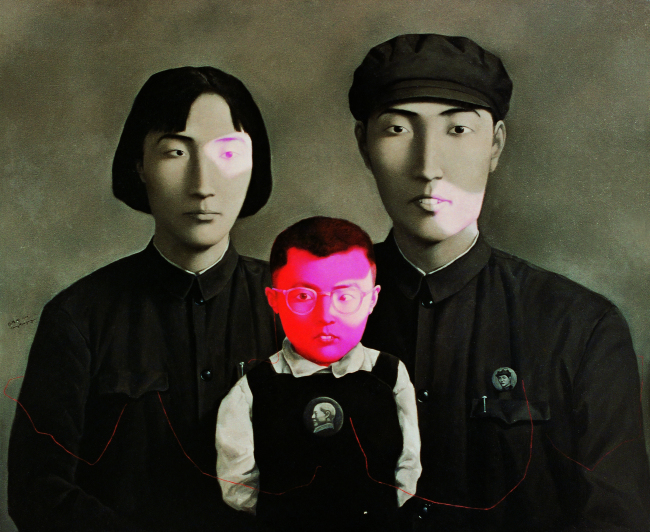Portraying ‘life and time’ for 30 years
Zhang Xiaogang talks about quest to establish Chinese identity in his art at Daegu Art Museum retrospective
By Lee Woo-youngPublished : June 17, 2014 - 20:40
Zhang Xiaogang is one of the most successful living Chinese artists, with his works setting records at international auctions. His famous “Bloodline ― Big Family” sold for HK$94.2 million ($12 million) at the Sotheby’s auction in Hong Kong in April last year. The artist, who led the unprecedented growth of the Chinese art market in the 2000s, is now looking back on his 30-year art career.
“It’s hard to sum up my 30-year art career in one word. But if I have to explain, the retrospective is about the life, time and ironies created throughout that time,” said Zhang at the press conference last week for his retrospective exhibition at Daegu Art Museum.
“Viewers can see both the time when I was full of artistic sentiments and dreams and the time I became older but was still immature inside.”
This is the artist’s second retrospective, following his first in Australia in 2009. The 105 artworks on display consist of his earlier works made in the 1980s and his recent human sculptures.
His works reflect not only his life but also the turbulent modern history of China.
“It’s hard to sum up my 30-year art career in one word. But if I have to explain, the retrospective is about the life, time and ironies created throughout that time,” said Zhang at the press conference last week for his retrospective exhibition at Daegu Art Museum.
“Viewers can see both the time when I was full of artistic sentiments and dreams and the time I became older but was still immature inside.”
This is the artist’s second retrospective, following his first in Australia in 2009. The 105 artworks on display consist of his earlier works made in the 1980s and his recent human sculptures.
His works reflect not only his life but also the turbulent modern history of China.

“My contemporaries and I are those who have experienced the most dynamic part of Chinese history. Through my works, viewers will observe 30 years of Chinese history experienced by one man,” he said.
Several paintings are symbolic for both the artist and China. “Tian’anmen No. 2” contrasts Tiananmen square in red with the surrounding area in gray. Zhang said the Tiananmen incident set the direction for his art after he returned from an inspiring trip to Europe.
“I was questioning myself, ‘Who am I?’ after I got back from Europe in 1992. When I looked at Tiananmen, I realized I am a Chinese living under the (shadow of) Tiananmen,” he said. Zhang saw Western masterpieces for the first time during his trip to Europe in 1992. The encounter with chef d’œuvres put him in a phase of deep soul-searching as a Chinese artist.
Meanwhile, the artist lived through turbulent events in China such as the Cultural Revolution (1966-1976), the Tiananmen massacre in 1989 and its dramatic economic growth.
In search of his artistic identity, Zhang accidentally found old photographs of his parents taken during the Cultural Revolution. He saw the influence of his country on his family portraits and began the “Bloodline” series, which features expressionless faces of family members in identical uniforms. In 1995, he was invited to exhibit the “Bloodline” series at the Venice Biennale. He sold his first painting from the series in 1998. He was 40 at the time.
“Under the influence of the Cultural Revolution, most of my contemporaries and I have experienced cultural isolation. We didn’t know what was happening outside China. Many artists learned painting based on the principles of Social Realism. I was 21 when I first learned Impressionism and I first saw a Van Gogh painting when I was about to graduate from my art college,” he said.
In 2000, he began a new series that attempts to portray spaces in his old home during the time of the Cultural Revolution. “Green Wall: Sofa” portrays a typical Chinese living room, with the wall divided into two colors ― white and green ― and a sofa with a blanket draped on it.
The biggest recent incident in his life ― heart surgery ― is explored in a painting portraying bottles of his heart medicines and a twig with red flower blossoms.
Zhang is also unveiling his most recent works ― sculptures of characters from the “Bloodline” series. Girls and boys from the family portraits come alive in life-size head sculptures. A sculpted sofa and a bed also appeared in his paintings before. According to Kim Sun-hee, director of the museum, these are sculptures and at the same time paintings because he paints characters and objects on sculptures with oil paints.
Zhang said the best artworks are not those auctioned for record prices, but those that reflect what’s inside him. “If I can still paint and express what I have in my mind, that’s my happiness,” he said.
The exhibition continues through Sept. 10 at Daegu Art Museum. For more information, visit www.daeguartmuseum.org.
By Lee Woo-young (wylee@heraldcorp.com)



![[Exclusive] Korean military set to ban iPhones over 'security' concerns](http://res.heraldm.com/phpwas/restmb_idxmake.php?idx=644&simg=/content/image/2024/04/23/20240423050599_0.jpg&u=20240423183955)

![[Graphic News] 77% of young Koreans still financially dependent](http://res.heraldm.com/phpwas/restmb_idxmake.php?idx=644&simg=/content/image/2024/04/22/20240422050762_0.gif&u=)



![[Pressure points] Leggings in public: Fashion statement or social faux pas?](http://res.heraldm.com/phpwas/restmb_idxmake.php?idx=644&simg=/content/image/2024/04/23/20240423050669_0.jpg&u=)









